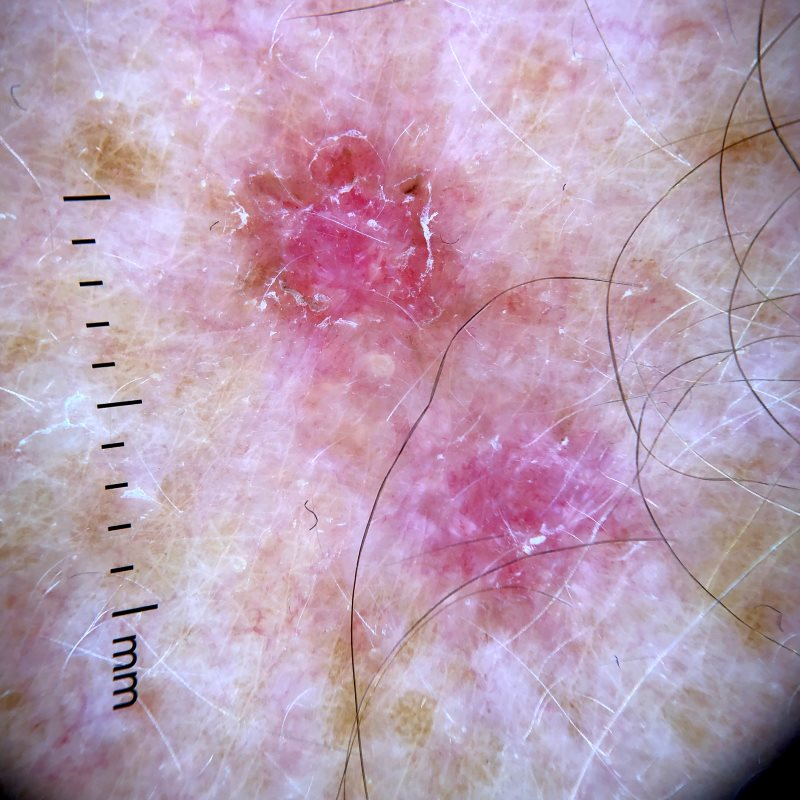Squamous Cell Carcinoma (SCC) is a common type of skin cancer that often develops in areas exposed to the sun’s harmful ultraviolet (UV) rays. Unlike Melanoma and BCC, SCC is likely attributable to lifelong exposure to UV. SCC is treatable when detected early, making it essential for patients to be informed about its types, characteristics, and risk factors. Additionally, SCC can vary in differentiation, which affects its aggressiveness.
Squamous cell carcinoma
Types of Squamous Cell Carcinoma
Squamous Cell Carcinoma
Description and Appearance: All SCC is invasive which refers to a lesion which has penetrated into the second layer of skin (dermis) potentially spreading to other areas. This presents a high risk lesion particularly on the head and neck.
Common Locations: Areas with a history of chronic sun exposure such as face, scalp, ears, lips, neck, backs of hands.
Symptoms and Signs:May present as an enlarging, non-healing ulcer or thickened, scaly lesion. Tenderness is often associated.
Treatment Options: Wide excision, may require other treatment such as radiation therapy.
Differentiation of SCC
Squamous Cell Carcinoma (SCC) can be classified into different degrees of differentiation, which refers to how closely the cancer cells resemble normal skin cells. The differentiation level can influence the tumor’s aggressiveness and potential for metastasis.
Well-Differentiated SCC
Description: Well-differentiated SCC contains cancer cells that closely resemble normal skin cells.
Characteristics: Slower growth rate
Less likely to invade nearby tissues
Lower risk of metastasis (spreading to other parts of the body)
Treatment Options: Surgical removal
Moderately Differentiated SCC
Description: Moderately differentiated SCC contains cancer cells that show some abnormal features but still have some resemblance to normal skin cells.
Characteristics: Moderate growth rate
Moderate risk of invasion into nearby tissues
Moderate risk of metastasis (depending on size and location)
Treatment Options: Surgical removal, often with a wider margin, may be recommended.


Poorly Differentiated SCC
Description: Poorly differentiated SCC contains cancer cells that appear highly abnormal and do not resemble normal skin cells.
Characteristics: Rapid growth rate
High risk of invading nearby tissues
Higher risk of metastasis
Treatment Options: Aggressive treatment may be necessary, which could include wider excision and radiation therapy.
Bowen’s Disease (In Situ SCC)
Description and Appearance: SCC I situ means a full thickness outler layer (epidermis) of abnormal cells. Only 5% of these will penertrate into the second layer and become invasive SCC. They appear as a red, scaly patch that may resemble eczema or psoriasis.
Common Locations: Lower legs, neck, and head.
Symptoms and Signs: Persistent, scaly, reddish patch that doesn’t heal.
Treatment Options: Cryosurgery, topical therapies such as Efudix, Excision, photodynamic therapy.
Keratoacanthoma (KA)
Description and Appearance: Keratoacanthoma is a fast-growing, dome-shaped nodule with a central crater filled with keratin. They can double in size over a few weeks.
Common Locations: Sun-exposed areas like the face, neck, hands, and arms.
Symptoms and Signs: Rapid development over a few weeks, resembling a volcano. Some undergo stabilization and possible spontaneous resolution. They are difficult to differentiate between a well differentiated SCC and as such often need excision.
Treatment Options: Surgical removal, cryosurgery, topical therapies.
RISK FACTORS AND PREVENTION
Risk Factors for Developing SCC
- Prolonged sun exposure
- History of sunburns
- Fair skin
- Advanced age
- Weakened immune system
- Previous skin cancer diagnosis
- Smoking
- Sun Beds / Solariums
- Chemical burns
- Arsenic exposure
Prevention Strategies
- Apply broad-spectrum sunscreen with SPF 30 or higher.
- Wear protective clothing, including long sleeves, hats, and sunglasses.
- Seek shade during peak sun hours.
- Avoid tanning beds and sunlamps.
- Conduct regular self-skin checks and seek professional evaluation if you notice any changes.


DIAGNOSIS AND SCREENING
How SCC is Diagnosed
Clinical examination by your GP or skin doctor.
Skin biopsy for confirmation and determining the extent of invasion and subtype.
The Role of The Skin Cancer Clinic Claremont in Early Detection
Skin Doctors play a critical role in diagnosing and treating SCC. Regular skin checks by a skin doctor can lead to the early detection and successful treatment of SCC.
Early intervention is vital for the best outcomes. If you observe any unusual skin changes or have concerns about skin cancer, consult our team promptly.
BOOK NOW
Our handpicked team of doctors, nurses and health professionals are here to make a meaningful difference to your life, at every stage of your life.

